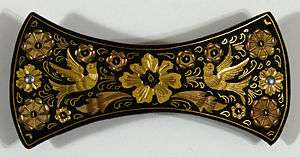Damascening
Damascening is the art of inlaying different metals into one another—typically, gold or silver into a darkly oxidized steel background—to produce intricate patterns similar to niello. The English term comes from a perceived resemblance to the rich tapestry patterns of damask silk.
The technique has a long history in Japan, where it was used to decorate katana fittings, particularly tsuba. Known as zougan(象嵌) in Japanese, it has developed its own subset of terms to describe the particular patterns, although "shippou-zougan" is an enamelling technique which most Westerners would consider closer to champlevé.
Damascened-inlay jewelry, especially of Japanese origin, is sometimes referred to as shakudo from the use of that alloy as the dark background.
The technique of niello is also famously attested in prehistoric Greece. The earliest occurrence of damascening in the Aegean, from the Shaft Graves of Mycenae, dates to the latest Middle Bronze Age/Middle Helladic IIIB period (dagger Nu-304). Ultimately of Near Eastern provenance, the technique of inlaying silver/gold was adapted to suit Aegean taste and style.
Cities that are known for a rich history in Damascening where the technique is still practiced are Malaysia, Indonesia, Toledo, Spain, Eibar, Basque Country and Kyoto, Japan.
Damascene in Toledo, Spain
Damascene arrived to Toledo from Damascus. Nevertheless, the art has long been practised in Persia, Japan and even China.

Damascene ware - damasquinado or damasquino, in Spanish - is the art of decorating steel with threads of gold and silver. Toledo has developed a very important industry around this craft, also known as Toledo Gold. The art of damascene has passed from generation to generation within the same family for centuries, and has become a hallmark of this beautiful city. Toledo supplies to many shops in Spain where the damascene pieces are sold as a souvenir.
During the last few decades the production of damascene has moved away from a purely handmade process, and many machine-made damascened items - some made not of blackened steel, but of cheap tin - have flooded the market. Some of these reproductions are "so expertly produced that even knowledgeable Toledeans admit the difficulty of recognizing them as such."[1] However, many shops still offer handcrafted damascened work following the tradition of ancient times, and it is possible to see artisans at work creating these painstaking and time-consuming works of art.
Damascene work has kept to traditional designs with few changes over the years, but there are a few handicraft workers who design innovative pieces of jewelry, which later are sold in some of the shops of the city (not in all). Nowadays you can find also craftsmen who perform high quality pieces, commissioned by private customers or collectors.

For many years the damascene style of jewelry in Toledo has been relatively unknown even to the citizens of Toledo, because the craft shops are located in the historic center of the city, a tourist area quite remote from the daily life of the residents of the city. [citation needed]
The damascene style renewal comes from the descendants of ancient craftsmen, who innovate with youthful designs. The two pendants shown at left in gold and silver, one with Swarovski crystals, are examples of the newer handmade style.
See also
References
- ↑ "DAMASCENE WARE IN SPAIN'S TOLEDO". The New York Times. 1982-04-11. ISSN 0362-4331. Retrieved 2016-06-20.
External links
- Ding bronze vessel with gold and silver inlay (Damascening) from the Warring States period (403-221 BC) of ancient China. (c. 300 BC)
 Detail of damascening, in this case gold inlaid into oxidized steel, in a hairclasp from Toledo, Spain.
Detail of damascening, in this case gold inlaid into oxidized steel, in a hairclasp from Toledo, Spain.
| Wikimedia Commons has media related to Damascening. |
- Demonstration of the technique as practiced in Toledo, Spain
- El Arte de Toledo
 "Damascening". Encyclopædia Britannica (11th ed.). 1911.
"Damascening". Encyclopædia Britannica (11th ed.). 1911.